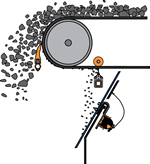 Martin Engineering offers an innovative solution that prevents carryback released by secondary conveyor belt cleaners from sticking to the rear slope of the discharge chute. If left to build up, material can encapsulate secondary cleaners and deposit harmful carryback onto the return side of the belt, fouling idlers and pulleys.
Martin Engineering offers an innovative solution that prevents carryback released by secondary conveyor belt cleaners from sticking to the rear slope of the discharge chute. If left to build up, material can encapsulate secondary cleaners and deposit harmful carryback onto the return side of the belt, fouling idlers and pulleys.
The Martin Vibrating Dribble Chute uses material disruption to cause tacky sludge and fines to fall from the chute wall and back into the main discharge flow. By addressing these issues, operators can experience a reduction in maintenance hours, equipment replacement and downtime, lowering the overall cost of operation.
Prompted by customer requests, Martin engineers observed that the majority of the buildup released by secondary cleaners collected at the rear of the chute mouth, where a sloped surface can trap carryback. According to Dan Marshall, product engineer for Martin Engineering, “We discovered that this could happen with nearly every discharge chute conveying adherent material. In some cases, even chutes treated with a low-friction coating can experience buildup. It’s only with the persistent disruption from vibration that we found materials flowed consistently.”
Comprised of three parts, a low-friction polyurethane dribble sheet, a steel mounting bracket and a powerful vibrator, the combination of mechanical disruption and the slick surface prevents material from adhering and feeds it back into the main discharge flow. When the unit is mounted into the existing chute-work, it often extends the rear configuration closer to the belt, increasing the amount of material captured and further reducing spillage.
Sum Of Its Parts
To install the dribble chute, a slot is created in the rear sloped wall to accommodate a steel hook bracket that secures the unit to the chute. Lined with thick soft rubber on the inside arch to protect the chute from structural abrasion caused by constant vibration, the J-shaped bracket holds the dribble sheet secure with four bolts. Able to be field-modified to fit the width and length of any chute with the necessary belt clearance, a thick and rigid sheet of abrasion-resistant ultra-high molecular weight (UHMW) polyethylene is installed in an elevated position parallel to the chute floor, so the sheet is free to vibrate.
Bolted to the other side of the bracket, outside of the chute, is a Martin Electric Vibrator, chosen by operators based on the needs of the application. Rated for continuous duty even when set at a maximum force output level, the units are housed in a totally enclosed, non-ventilated (TENV) case to keep internal components protected from abrasive dust. The electric rotary motor can be as large as 230-460 volt, 3 phase, 50/60 Hz and runs as fast as 3,450 rpm at a centrifugal force output of up to 16,500 lb. Internal class H windings are triple dipped, shock resistant and able to operate under sustained internal temperatures as high as 356 F (180 C).
Martin Engineering, www.martin-eng.com

